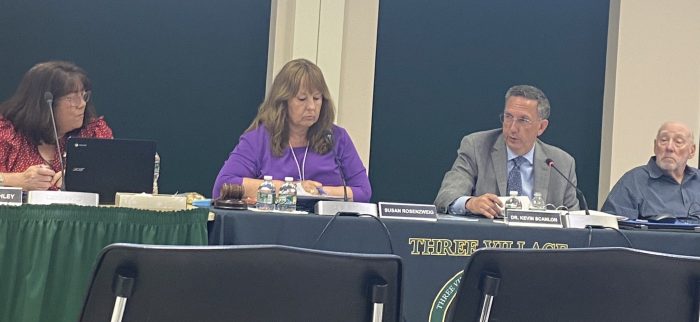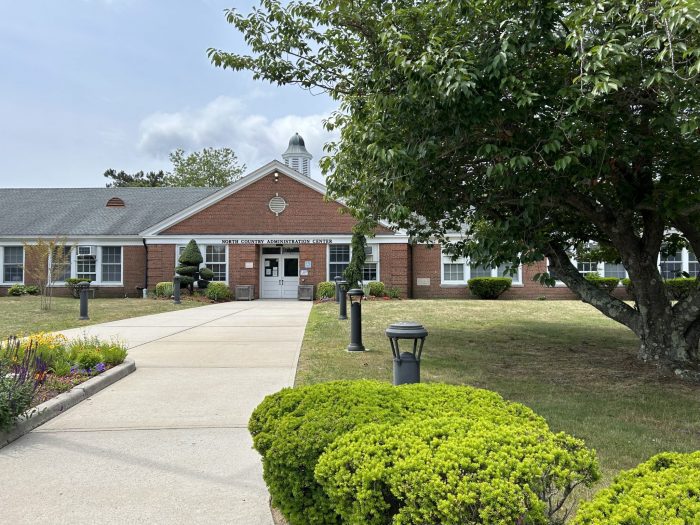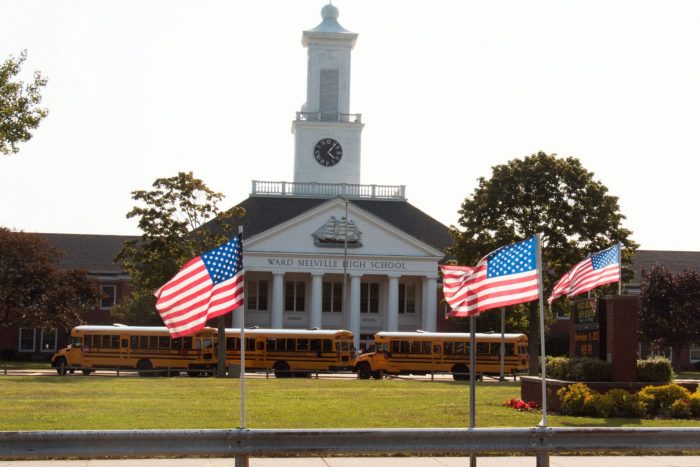By William Stieglitz
The April 30 Three Village Central School District Board of Education meeting began with updates on the question of whether to arm school security guards. The district surveyed around 1,400 employees, with 55% saying they were for armed security and 45% saying they were against. Of the 55% in favor, 81% wanted security armed both inside and outside of the school. The board plans to survey the community next and said that, when ready, they will likely make the survey available through either an online link or the student database system Infinite Campus.
The board also announced that the ZeroEyes security system, an artificial intelligence weapons detection software that the district has been looking into since October, is finally up and running. The system connects school cameras to AI that scans the footage firearms and alerts the district and authorities in a matter of seconds if something is found.
“We got a chance to do some calibration and test it at this building and Mount Elementary,” said security coordinator Jack Blaum, speaking from the North Country Administration Building. “And I will tell you, I am absolutely impressed with the system.” He said that while the technology is only one part of a solution, he is confident it will act as a deterrent and that other local districts have expressed interest in implementing ZeroEyes as well.
In school funding news, the board announced that following their April 9 decision to remove earlier high school start times from this year’s planned budget, they were left with $1,014,000 to spend on other programs, as well as an additional $100,000 from savings in the textbook code. The board unanimously chose to use $760,000 from this to restore seven elementary school teachers and thereby reduce class sizes, which left around $340,000 to discuss.
One option was to use $100,000 to restore fourth-grade science, technology, engineering and mathematics. Unlike the district’s previous STEM program, which ended during COVID and had allowed a STEM teacher in every building for every grade level, this would start smaller by having a STEM teacher go to each school for one day a week. Another option would be to restore the Intellectually Gifted Program, though with $100,000 costs for both staffing and transportation, this would be twice as expensive. A third option was to use an estimated $70,000 to restore summer reading programs, which would also require a new program coordinator.
Following debate, the board voted 5-1 (David McKinnon was absent) for using the funds to restore STEM and summer reading, with the rest being saved for future costs. While funding for fourth-grade IG was also discussed, this only received two out of six votes. “Whereas IG services a smaller number, the STEM program would service an entire grade level,” Superintendent Kevin Scanlon said when weighing the benefits of each. “We’re talking over 400 students being addressed there.”
The board also reviewed the district’s success in programming for Autism Acceptance Month. Schools such as Arrowhead, Minnesauke, W.S. Mount and Murphy elementary schools and Gelinas Jr. High school held assemblies, fundraisers, schoolwide walks and other related activities. “I think it’s important that we recognize all the students that we have in our district,” said Scanlon. “The population of autism has been diagnosed more readily in the more recent years, and I think that’s where we excel in this district, because of our attention to our students with special needs… I think this is a way of recognizing them in a special way.”
Another kind of assembly, exclusive to eighth graders at Gelinas, was a live performance of “From the Fires: Voices of the Holocaust,” which included a discussion with the cast. This was paired with interactive classes, led by Principal Corinne Keane and social studies teacher Christina Cone, on how to identify and combat antisemitism and other hate speech.
One more thing that brought students to school theaters this month was the spring musicals. These included performances of “Finding Nemo Junior” at Minnesauke, “Seussical the Musical” at Mount, “Beauty and the Beast” at Nassakeag Elementary School, “You’re a Good Man, Charlie Brown” at Setauket, “Newsies” at Gelinas and “Anastasia” at Murphy.
For more information visit the school website: www.threevillagecsd.org.







